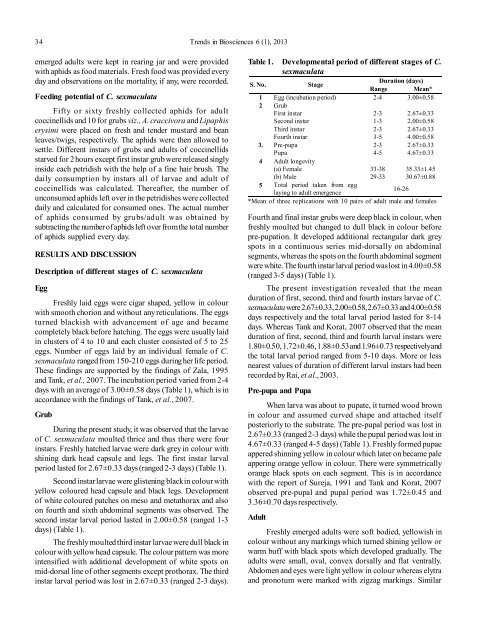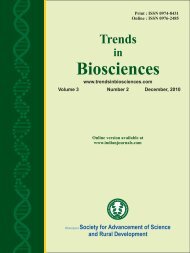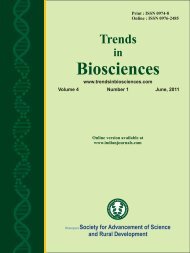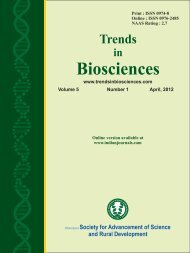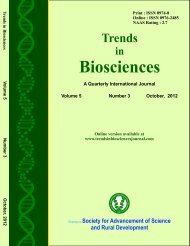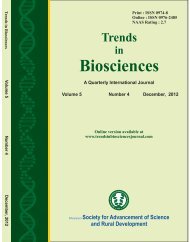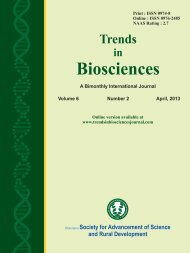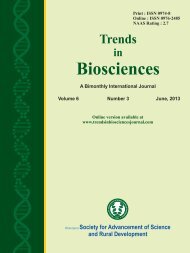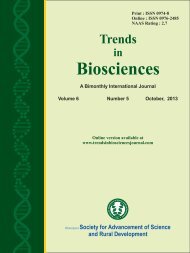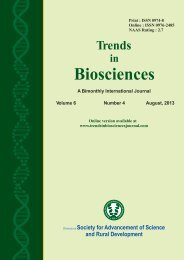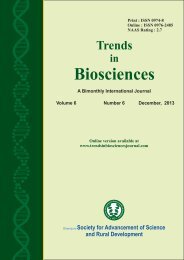TRENDS IN BIOSCIENCES 6-1, 2013 EDITION
CALL FOR RESEARCH PAPERS
CALL FOR RESEARCH PAPERS
You also want an ePaper? Increase the reach of your titles
YUMPU automatically turns print PDFs into web optimized ePapers that Google loves.
34 Trends in Biosciences 6 (1), <strong>2013</strong><br />
emerged adults were kept in rearing jar and were provided<br />
with aphids as food materials. Fresh food was provided every<br />
day and observations on the mortality, if any, were recorded.<br />
Feeding potential of C. sexmaculata<br />
Fifty or sixty freshly collected aphids for adult<br />
coccinellids and 10 for grubs viz., A. craccivora and Lipaphis<br />
erysimi were placed on fresh and tender mustard and bean<br />
leaves/twigs, respectively. The aphids were then allowed to<br />
settle. Different instars of grubs and adults of coccinellids<br />
starved for 2 hours except first instar grub were released singly<br />
inside each petridish with the help of a fine hair brush. The<br />
daily consumption by instars all of larvae and adult of<br />
coccinellids was calculated. Thereafter, the number of<br />
unconsumed aphids left over in the petridishes were collected<br />
daily and calculated for consumed ones. The actual number<br />
of aphids consumed by grubs/adult was obtained by<br />
subtracting the number of aphids left over from the total number<br />
of aphids supplied every day.<br />
RESULTS AND DISCUSSION<br />
Description of different stages of C. sexmaculata<br />
Egg<br />
Freshly laid eggs were cigar shaped, yellow in colour<br />
with smooth chorion and without any reticulations. The eggs<br />
turned blackish with advancement of age and became<br />
completely black before hatching. The eggs were usually laid<br />
in clusters of 4 to 10 and each cluster consisted of 5 to 25<br />
eggs. Number of eggs laid by an individual female of C.<br />
sexmaculata ranged from 150-210 eggs during her life period.<br />
These findings are supported by the findings of Zala, 1995<br />
and Tank, et al., 2007. The incubation period varied from 2-4<br />
days with an average of 3.00±0.58 days (Table 1), which is in<br />
accordance with the findings of Tank, et al., 2007.<br />
Grub<br />
During the present study, it was observed that the larvae<br />
of C. sexmaculata moulted thrice and thus there were four<br />
instars. Freshly hatched larvae were dark grey in colour with<br />
shining dark head capsule and legs. The first instar larval<br />
period lasted for 2.67±0.33 days (ranged 2-3 days) (Table 1).<br />
Second instar larvae were glistening black in colour with<br />
yellow coloured head capsule and black legs. Development<br />
of white coloured patches on meso and metathorax and also<br />
on fourth and sixth abdominal segments was observed. The<br />
second instar larval period lasted in 2.00±0.58 (ranged 1-3<br />
days) (Table 1).<br />
The freshly moulted third instar larvae were dull black in<br />
colour with yellow head capsule. The colour pattern was more<br />
intensified with additional development of white spots on<br />
mid-dorsal line of other segments except prothorax. The third<br />
instar larval period was lost in 2.67±0.33 (ranged 2-3 days).<br />
Table 1. Developmental period of different stages of C.<br />
sexmaculata<br />
S. No. Stage<br />
Duration (days)<br />
Range Mean*<br />
1 Egg (incubation period) 2-4 3.00±0.58<br />
2 Grub<br />
First instar<br />
Second instar<br />
Third instar<br />
Fourth instar<br />
2-3<br />
1-3<br />
2-3<br />
3-5<br />
2.67±0.33<br />
2.00±0.58<br />
2.67±0.33<br />
4.00±0.58<br />
3. Pre-pupa<br />
Pupa<br />
2-3<br />
4-5<br />
2.67±0.33<br />
4.67±0.33<br />
4 Adult longevity<br />
(a) Female<br />
(b) Male<br />
33-38<br />
29-33<br />
35.33±1.45<br />
30.67±0.88<br />
5 Total period taken from egg<br />
laying to adult emergence<br />
16-26<br />
*Mean of three replications with 10 pairs of adult male and females<br />
Fourth and final instar grubs were deep black in colour, when<br />
freshly moulted but changed to dull black in colour before<br />
pre-pupation. It developed additional rectangular dark grey<br />
spots in a continuous series mid-dorsally on abdominal<br />
segments, whereas the spots on the fourth abdominal segment<br />
were white. The fourth instar larval period was lost in 4.00±0.58<br />
(ranged 3-5 days) (Table 1).<br />
The present investigation revealed that the mean<br />
duration of first, second, third and fourth instars larvae of C.<br />
sexmaculata were 2.67±0.33, 2.00±0.58, 2.67±0.33 and 4.00±0.58<br />
days respectively and the total larval period lasted for 8-14<br />
days. Whereas Tank and Korat, 2007 observed that the mean<br />
duration of first, second, third and fourth larval instars were<br />
1.80±0.50, 1.72±0.46, 1.88±0.53 and 1.96±0.73 respectively and<br />
the total larval period ranged from 5-10 days. More or less<br />
nearest values of duration of different larval instars had been<br />
recorded by Rai, et al., 2003.<br />
Pre-pupa and Pupa<br />
When larva was about to pupate, it turned wood brown<br />
in colour and assumed curved shape and attached itself<br />
posteriorly to the substrate. The pre-pupal period was lost in<br />
2.67±0.33 (ranged 2-3 days) while the pupal period was lost in<br />
4.67±0.33 (ranged 4-5 days) (Table 1). Freshly formed pupae<br />
appered shinning yellow in colour which later on became pale<br />
appering orange yellow in colour. There were symmetrically<br />
orange black spots on each segment. This is in accordance<br />
with the report of Sureja, 1991 and Tank and Korat, 2007<br />
observed pre-pupal and pupal period was 1.72±0.45 and<br />
3.36±0.70 days respectively.<br />
Adult<br />
Freshly emerged adults were soft bodied, yellowish in<br />
colour without any markings which turned shining yellow or<br />
warm buff with black spots which developed gradually. The<br />
adults were small, oval, convex dorsally and flat ventrally.<br />
Abdomen and eyes were light yellow in colour whereas elytra<br />
and pronotum were marked with zigzag markings. Similar


